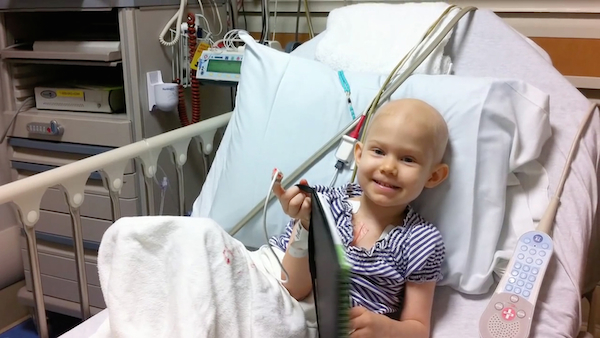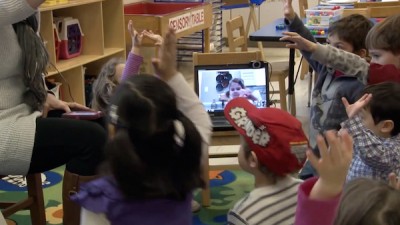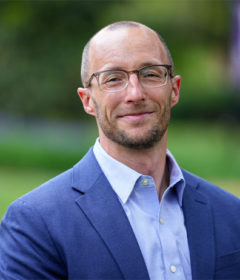Bringing Hope to the Smallest Patients
by Mary M. McCambridge
No one ever expects to see his or her child fighting a battle with cancer at the tender age of nine. But that’s exactly what Len and Elizabeth Forkas of Virginia faced when their son, Matt, was suddenly diagnosed with leukemia shortly after struggling to breathe while playing basketball.
Faced with this unthinkable turn of events, the Forkas’ bravely searched for ways to make this process for their family one that would help Matt not only survive but thrive. And, along the way, a national non-profit organization was born to address a very important need that had, to that point, never been considered.
Matt Forkas, currently a senior at Stetson University majoring in digital arts with a minor in business, endured the grueling experience of continual oncology appointments, blood transfusions, exhaustion and isolation in an effort to overcome this disease.
“My mom was always by my side,” Matt said. “I never felt scared or worried except during the blood transfusions.”

Matt’s best friend, Sava Nedelcovych, had been friends with Matt since they were five and they attended Forestville Elementary School together in northern Virginia. He still remembers the day Matt was pulled from class to receive his difficult diagnosis. When he returned home, Nedelcovych’s parents broke the news to him.
“My parents would let me sneak into the hospital and Matt and I would play video games to pass the time. I wasn’t afraid. He was the stronger one,” said Sava.
“Matt’s classmates were devastated when they learned he was sick and was not coming back to school,” recalls his fourth-grade teacher, Sheri Caligan. “I held a class meeting to explain the situation. It was a very emotional time.”
During the nine months that Matt was confined to his bed at home, his parents realized that he would feel much better emotionally if he could connect with his classmates on a regular basis. With a little ingenuity and persuading Matt’s school principal, a computer and webcam were installed in the back of his classroom. And the HopeCam was born.
Although a completely new idea, both Matt and the children at his school felt a renewed sense of connection. He was able to participate with his class in progress when he felt well and his friends would take turns sitting in front of the computer to chat with him.
“Having a tool like this whereby children can connect with their classmates, local and extended family, and keep up with their studies while enduring continuous cancer treatments, is quite valuable,” said Chris Ferguson, Ph.D., associate professor and chair of Psychology at Stetson. “Knowing they aren’t additionally isolated during this time provides the encouragement they need from those who love them and a more stable environment as they heal.”

Understanding how much this could help other children, Matt’s father, Len Forkas, who initially turned to exercise to cope with his son’s illness, used marathon running and later cycling to help raise funds to purchase hardware to create additional HopeCams for other children with cancer.
At a time when laptops were $2,000, webcams $100 and Skype not yet invented, Len had his friends “pay me to suffer.” Each run was a little longer leading up to the Iron Man Triathlon raising five times more money than previous marathons and ultimately his “Race Across America” where he cycled across the United States from Oceanside, Calif., to Annapolis, Md., in 12 days and is recounted in his book What Spins The Wheel – Leadership Lessons From Our Race for Hope. An exceptional team of volunteers orchestrated the national cycling trip raising over $300,000 for this growing non-profit.
Two years ago HopeCam welcomed Executive Director Susan Koehler who has helped the organization grow into a national cancer charity. Having personally experienced the loss of her own husband when her children were seven and eight years old, and as a cancer survivor herself, she clearly understood the needs of families who endured this trauma.
“There are 15,000 children diagnosed with cancer each year and 33,000 in treatment at any given moment,” Koehler said. “We wish they didn’t need us.”
While initially HopeCam was helping approximately 25 children each year, they have expanded to reaching slightly over 300 children by placing systems in classrooms and giving tablets to children who use them to connect to their classmates from doctors’ offices, hospitals and home during their treatments. They have built partnerships with Logitech, which has generously donated over 100 webcams including a special $1,000 camera with long-range microphone technology specifically to allow a young cancer patient to enjoy watching and hearing the high school play he produced from his bed.
HopeCam’s Program Manager Rachel Wheat and Program Coordinator Liz Moreno orchestrate the process and now help children in 34 states. To raise additional funds, Matt and Len Forkas decided to climb Mr. Kilimanjaro honoring a different young cancer patient each day of the trip.
When a family endures this type of tragedy, the entire family is affected.
“We shared the fear of the future since we didn’t know the outcome, the helplessness as parents, and Matt’s sister, our daughter Viena, was particularly affected by the lack of attention during his 2½ years of treatment,” Len said.
It’s been a long process for Matt, from cancer survivor to Stetson senior and the experience has changed him personally.
“I’m more appreciative of what I have, especially family,” said Matt. I feel grateful and am more conscious, mature and grounded. I’m more responsible and had to grow up quickly.”
But now, Matt looks forward to graduating in May, and enjoys audio engineering and music production. His work has produced a 10-song album including videos to accompany its songs. Nathan Wolek, Ph.D., associate professor of digital arts and chair of the Creative Arts Department, finds Matt’s quiet demeanor turns creative when he’s developing his own style of music.
Matt could never have known that from his pain and struggle an organization would be built which would help thousands of other children like him. HopeCam is a testament to the resiliency of a young man’s body and mind to heal and to the will of a family to make life better for him and those who endured similar experiences.
The following CNN video clip, “Healing Through HopeCams,” is preceded by a brief advertisement that is connected to the video share.



